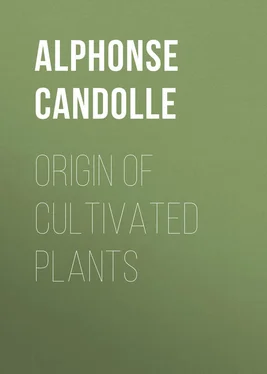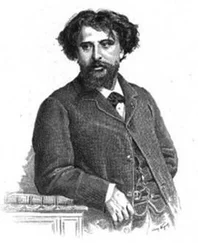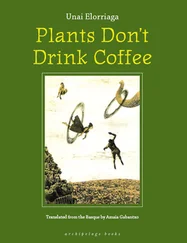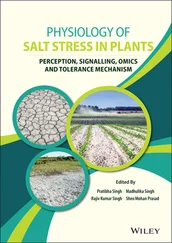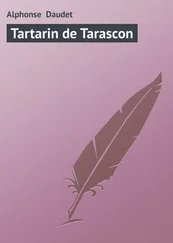Alphonse Candolle - Origin of Cultivated Plants
Здесь есть возможность читать онлайн «Alphonse Candolle - Origin of Cultivated Plants» — ознакомительный отрывок электронной книги совершенно бесплатно, а после прочтения отрывка купить полную версию. В некоторых случаях можно слушать аудио, скачать через торрент в формате fb2 и присутствует краткое содержание. Жанр: foreign_antique, foreign_prose, на английском языке. Описание произведения, (предисловие) а так же отзывы посетителей доступны на портале библиотеки ЛибКат.
- Название:Origin of Cultivated Plants
- Автор:
- Жанр:
- Год:неизвестен
- ISBN:нет данных
- Рейтинг книги:4 / 5. Голосов: 1
-
Избранное:Добавить в избранное
- Отзывы:
-
Ваша оценка:
- 80
- 1
- 2
- 3
- 4
- 5
Origin of Cultivated Plants: краткое содержание, описание и аннотация
Предлагаем к чтению аннотацию, описание, краткое содержание или предисловие (зависит от того, что написал сам автор книги «Origin of Cultivated Plants»). Если вы не нашли необходимую информацию о книге — напишите в комментариях, мы постараемся отыскать её.
Origin of Cultivated Plants — читать онлайн ознакомительный отрывок
Ниже представлен текст книги, разбитый по страницам. Система сохранения места последней прочитанной страницы, позволяет с удобством читать онлайн бесплатно книгу «Origin of Cultivated Plants», без необходимости каждый раз заново искать на чём Вы остановились. Поставьте закладку, и сможете в любой момент перейти на страницу, на которой закончили чтение.
Интервал:
Закладка:
4. History. Historical records are important in order to determine the date of certain cultures in each country. They also give indications as to the geographical origin of plants when they have been propagated by the migrations of ancient peoples, by travellers, or by military expeditions.
The assertions of authors must not, however, be accepted without examination.
The greater number of ancient historians have confused the fact of the cultivation of a species in a country with that of its previous existence there in a wild state. It has been commonly asserted, even in our own day, that a species cultivated in America or China is a native of America or China. A no less common error is the belief that a species comes originally from a given country because it has come to us from thence, and not direct from the place in which it is really indigenous. Thus the Greeks and Romans called the peach the Persian apple, because they had seen it cultivated in Persia, where it probably did not grow wild. It was a native of China, as I have elsewhere shown. They called the pomegranate, which had spread gradually from garden to garden from Persia to Mauritania, the apple of Carthage ( Malum Punicum ). Very ancient authors, such as Herodotus and Berosius, are yet more liable to error, in spite of their desire to be accurate.
We shall see, when we speak of maize, that historical documents which are complete forgeries may deceive us about the origin of a species. It is curious, for it seems to be no one’s interest to lie about such agricultural facts. Fortunately, facts of botany and archæology enable us to detect errors of this nature.
The principal difficulty, which commonly occurs in the case of ancient historians, is to find the exact translation of the names of plants, which in their books always bear the common names. I shall speak presently of the value of these names and how the science of language may be brought to bear on the questions with which we are occupied, but I must first indicate those historical notions which are most useful in the study of cultivated plants.
Agriculture came originally, at least so far as the principal species are concerned, from three great regions, in which certain plants grew, regions which had no communication with each other. These are – China, the south-west of Asia (with Egypt), and intertropical America. I do not mean to say that in Europe, in Africa, and elsewhere savage tribes may not have cultivated a few species locally, at an early epoch, as an addition to the resources of hunting and fishing; but the great civilizations based upon agriculture began in the three regions I have indicated. It is worthy of note that in the old world agricultural communities established themselves along the banks of the rivers, whereas in America they dwelt on the high lands of Mexico and Peru. This may perhaps have been due to the original situation of the plants suitable for cultivation, for the banks of the Mississippi, of the Amazon, of the Orinoco, are not more unhealthy than those of the rivers of the old world.
A few words about each of the three regions.
China had already possessed for some thousands of years a flourishing agriculture and even horticulture, when she entered for the first time into relations with Western Asia, by the mission of Chang-Kien, during the reign of the Emperor Wu-ti, in the second century before the Christian era. The records, known as Pent-sao, written in our Middle Ages, state that he brought back the bean, the cucumber, the lucern, the saffron, the sesame, the walnut, the pea, spinach, the water-melon, and other western plants, 13 13 Bretscheider, On the Study and Value , etc., p. 15.
then unknown to the Chinese. Chang-Kien, it will be observed, was no ordinary ambassador. He considerably enlarged the geographical knowledge, and improved the economic condition of his countrymen. It is true that he was constrained to dwell ten years in the West, and that he belonged to an already civilized people, one of whose emperors had, 2700 B.C., consecrated with imposing ceremonies the cultivation of certain plants. The Mongolians were too barbarous, and came from too cold a country, to have been able to introduce many useful species into China; but when we consider the origin of the peach and the apricot, we shall see that these plants were brought into China from Western Asia, probably by isolated travellers, merchants or others, who passed north of the Himalayas. A few species spread in the same way into China from the West before the embassy of Chang-Kien.
Regular communication between China and India only began in the time of Chang-Kien, and by the circuitous way of Bactriana; 14 14 Ibid.
but gradual transmissions from place to place may have been effected through the Malay Peninsula and Cochin-China. The writers of Northern China may have been ignorant of them, and especially since the southern provinces were only united to the empire in the second century before Christ. 15 15 Ibid. , p. 23.
Regular communications between China and Japan only took place about the year 57 of our era, when an ambassador was sent; and the Chinese had no real knowledge of their eastern neighbours until the third century, when the Chinese character was introduced into Japan. 16 16 Atsuma-gusa. Recueil pour servir à la connaissance de l’extrême Orient , Turretini, vol. vi., pp. 200, 293.
The vast region which stretches from the Ganges to Armenia and the Nile was not in ancient times so isolated as China. Its inhabitants exchanged cultivated plants with great facility, and even transported them to a distance. It is enough to remember that ancient migrations and conquests continually intermixed the Turanian, Aryan, and Semitic peoples between the Caspian Sea, Mesopotamia, and the Nile. Great states were formed nearly at the same time on the banks of the Euphrates and in Egypt, but they succeeded to tribes which had already cultivated certain plants. Agriculture is older in that region than Babylon and the first Egyptian dynasties, which date from more than four thousand years ago. The Assyrian and Egyptian empires afterwards fought for supremacy, and in their struggles they transported whole nations, which could not fail to spread cultivated species. On the other hand, the Aryan tribes who dwelt originally to the north of Mesopotamia, in a land less favourable to agriculture, spread westward and southward, driving out or subjugating the Turanian and Dravidian nations. Their speech, and those which are derived from it in Europe and Hindustan, show that they knew and transported several useful species. 17 17 There are in the French language two excellent works, which give the sum of modern knowledge with regard to the East and Egypt. The one is the Manuel de l’Histoire Ancienne de l’Orient , by François Lenormand, 3 vols. in 12mo, Paris, 1869; the other, L’Histoire Ancienne des Peuples de l’Orient , by Maspero, 1 vol. in 8vo, Paris, 1878.
After these ancient events, of which the dates are for the most part uncertain, the voyages of the Phœnicians, the wars between the Greeks and Persians, Alexander’s expedition into India, and finally the Roman rule, completed the spread of cultivation in the interior of Western Asia, and even introduced it into Europe and the north of Africa, wherever the climate permitted.
Later, at the time of the crusades, very few useful plants yet remained to be brought from the East. A few varieties of fruit trees which the Romans did not possess, and some ornamental plants, were, however, then brought to Europe.
The discovery of America in 1492 was the last great event which caused the diffusion of cultivated plants into all countries. The American species, such as the potato, maize, the prickly pear, tobacco, etc., were first imported into Europe and Asia. Then a number of species from the old world were introduced into America. The voyage of Magellan (1520-1521) was the first direct communication between South America and Asia. In the same century the slave trade multiplied communications between Africa and America. Lastly, the discovery of the Pacific Islands in the eighteenth century, and the growing facility of the means of communication, combined with a general idea of improvement, produced that more general dispersion of useful plants of which we are witnesses at the present day.
Читать дальшеИнтервал:
Закладка:
Похожие книги на «Origin of Cultivated Plants»
Представляем Вашему вниманию похожие книги на «Origin of Cultivated Plants» списком для выбора. Мы отобрали схожую по названию и смыслу литературу в надежде предоставить читателям больше вариантов отыскать новые, интересные, ещё непрочитанные произведения.
Обсуждение, отзывы о книге «Origin of Cultivated Plants» и просто собственные мнения читателей. Оставьте ваши комментарии, напишите, что Вы думаете о произведении, его смысле или главных героях. Укажите что конкретно понравилось, а что нет, и почему Вы так считаете.
